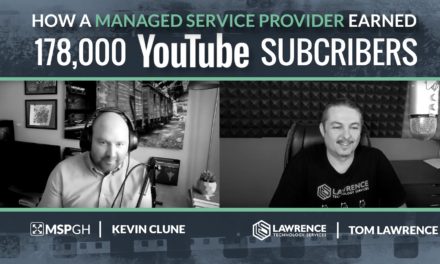While I have been talking about growing Managed IT companies on this site for over 2 years now, it recently dawned on me that I’ve never fully addressed what I would do differently if I had the opportunity. While I won’t be starting an MSP from scratch any time soon, it is fun to think through the possibilities and mentally reconstruct a business that would be equipped to compete in today’s market. Here are a few of the major differences between that company, and the company we exited from in 2018:
Identity-Driven Value Propositions
Our IT company was all-in on selling “white-glove” IT support. In fact, we were so dedicated to this concept that we rebranded our company with a bow-tie derived logo and created an illustrated butler mascot named “Winston Techworth” to go with it. While I still love how fun and engaging our branding was to this day, I don’t think I would be bringing Winston out of retirement any time soon. That’s because he was a symbol of “support” which I don’t think deserves the emphasis that it once did.
By de-emphasizing support in favor of more consultative, higher value offerings, it opens up the door to outsource support functions at scale. In the last few years of our company, we outsourced the very help desk which we labeled “white glove” which gave us far less control over the quality, but allowed us to scale faster and more affordably. This branding suddenly no longer felt authentic, which is why when doing it over again, I would dig deeper into our core identity and align our value more with our strengths.
Limited Fixed-Rate Support Contracts
If there was one thing that kept us up at night and led to hundreds of hours searching our accounting software and PSA for answers, it was our all-you-can-eat service contracts. There was a short period of time where it seemed like the more new customers we brought on, the less profitable we became as if we were stuck in quicksand struggling to get out. What we eventually learned was that not every client needed a fixed-rate contract (nor did they want one) and to be honest, it was a privilege that should be earned through qualification.
If I were to do it over again in today’s market, I would stay away from fixed-rate labor whenever possible. I would create a system similar to the one we eventually developed (which I talked about in my book) which would allow customers to earn a fair fixed rate over time. I would also be quicker to sniff out projects that were disguised as support requests and put them through the proper channels so that they don’t turn into resourcing gobbling monsters, protecting my limited labor force at all cost.
The Ultimate Guide To Cash Flow For Managed Services
Sponsored by Alternative Payments & Zest
Enabling Self-Service Transactions
One of the most frustrating parts of being an IT Provider was the sales cycle. For you to properly discover, qualify, quote, review, and follow up requires hours of time and energy, that didn’t need to be exhausted. It also makes it incredibly frustrating when you put all of this effort in only for a competitor to undercut your exact quote and take the deal for themselves.
This is why I would invest heavily into enabling customers to purchase service bundles, hardware, pre-scoped projects, and add-ons in an e-commerce environment. I would qualify and/or disqualify these transactions after they have been authorized, this way I know that the deal is already won and there is little risk in doing so. This also forces us to streamline and simplify our offerings in a way that is both easy for the customer to understand on their own and easier for us to process and deliver on the back end through automation.
Outsourced Security Partner
When I was an MSP, cybersecurity was in a very different state than it is now. We of course deployed the standards in network edge and endpoint security, but by no means were we specialized in this area. To me this is the most dramatic transition that I have witnessed between my time as an MSP and now, as it is almost impossible to be an MSP without bearing the full weight of the cyber threat landscape on your shoulders.
Going back to my thoughts on aligning our values with our true identity, I would take the same approach when it comes cybersecurity. Rather than having to expend my own resources in this area, I would partner with a company who has the utmost experience and can stay ahead of security trends in a way that would almost be impossible for us to do internally. This may be through a vendor relationship or referral partnership depending on the specifics, but I know that to truly offer a best in-class security solution, it can’t be half-baked by busy network engineers.
More “Mutual Client” Partnerships
When I look back, I realize that some of our best clients actually came from partnerships with other providers that were also servicing the clients in some other of their business. In our case these came in the form of software, managed print, property management, marketing and telecom providers. All of these partnerships essentially started the same way; we acquired a client that also happened to be doing business with this other entity, we were forced to interact the other entity to support our mutual client, the other entity saw value through our interaction, they referred us to their other mutual clients as a result.
Now that I have had some time to reflect on this and realize the value of these relationships, I would no longer take a serendipitous approach to developing them. I would make purposefully engage with every one of the our clients other providers and extend our value to them anyway I could. This is something that takes very little time and energy to do, but can have a major impact on the overall outcome.
The Ultimate Guide To Cash Flow For Managed Services
Sponsored by Alternative Payments & Zest
Increased Focus On Data
When I was an MSP, we had somewhat of a backward approach to list-building. Our primary marketing initiatives were to buy contact data by the tens of thousands, and use automation to nurture opportunities into existence. Put simply, this is the direct response “cold email” approach, that seems to work until it doesn’t. We generated a ton of leads this way, but unfortunately we burned through all the data we could get our hands on and thus this strategy only became less effective over time.
If there is anything I have learned over the past few years of running this website and helping MSPs with their growth, it is the power of organic list-building and owning your audience. I would put as many resources as I could into creating lead magnets, hosting events, and developing tools and resources so that I had as many data collection points as possible. Once this data is collected, I would nurture the audience with a weekly newsletter (much like we do here) and a frequent stream of limited time offers pointing to our e-commerce front-end.
More Networking Between Clients
If there was one thing that I have witnessed work for other MSPs, that I missed out on completely, it’s networking clients together to form a more tight-knit community around your brand. Being connected with hundreds of small businesses (whether in a local area or industry vertical) gives you a substantial amount of referral power that you may not realize you have. While I have never been a fan of networking groups that force this type of behavior, I can see this working in a more organic and thoughtful way.
I would look to integrate this initiative with my in-person and virtual event strategies, to ensure that there was always peer-to-peer networking taking place between my clients and prospects at all times. I would also offer up an introduction to any present or former client employee looking to find a new job, as long as it is not disruptive to the customers involved. This is the type of karma that you can never have enough of, as it always seems to come full circle at an opportune time.

SPONSORED BY ZEST

















